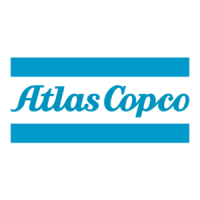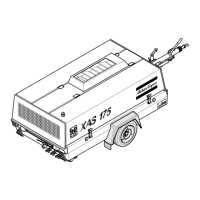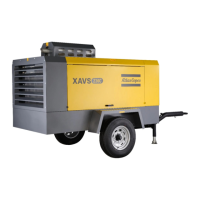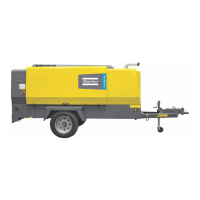8 1310 3011 73
1.8 Pressure vessels
Maintenance / installation requirements:
1 The vessel can be used as a pressure vessel or as a
separator and is designed to hold compressed air for
the following applications:
- pressure vessel for compressor.
- medium AIR/OIL,
and operates as detailed on the data plate of the
vessel:
- the maximum working pressure in psi,
2 The pressure vessel is only to be used for the
applications as specified above and in accordance with
the technical specifications. Safety reasons prohibit
any other applications.
3 National legislation requirements with respect to re-
inspection must be complied with.
4 No welding or heat treatment of any kind is permitted
to those vessel walls which are exposed to pressure.
5 The vessel is provided and may only be used with the
required safety equipment such as pressure guage,
overpressure control devices, safety valve, etc.
6 Draining of condensate shall be performed regularly
when vessel is in use.
7 Installation, design and connections should not be
changed.
8 Bolts of cover and flanges may not be used for extra
fixation.
1.9 Safety valve
All adjustments or repairs are to be done by an authorized
representative of the valve supplier.
Following checks must be carried out:
1 A check of the opening of the lifting gear,1 or 2 times a
year. This can be done by lifting the ring or lever.
2 A check of the set pressure once a year according to
the local regulations, if required. This check may not
be done with the compressor supplying the air
pressure and must be carried out on a proper test
bench.
1.10 Injury Prevention
1 Stationary housing guards are provided on all rotating
or reciprocating parts not otherwise protected and
which may be hazardous to personnel. Machinery
shall never be put into operation, when such guards
have been removed, operate only when guards are
securely reinstalled.
2 Do not open electrical cabinets, cubicles or other
equipment while voltage is supplied. If such cannot be
avoided, e.g. for measurements, tests or adjustments,
have the action carried out by a
qualified electrician only, with appropriate tools, and
ascertain that the required bodily protection against
electrical hazards is applied.
3 Noise, even at reasonable levels, can cause irritation
and disturbance which, over a long period of time, may
cause severe injuries to the nervous system of human
beings.
When the sound pressure level, at any point where
personnel normally has to attend, is:
below 70 dB(A): no action needs to be taken,
above 70 dB(A): noise-protective devices should be
provided for people continuously being
present in the room,
below 85 dB(A): no action needs to be taken for
occasional visitors staying a limited time
only,
above 85 dB(A): room to be classified as a noise-
hazardous area and an obvious warning
shall be placed permanently at each
entrance to alert people entering the
room, for even relatively short times,
about the need to wear ear protectors,
above 95 dB(A): the warning(s) at the entrance(s) shall
be completed with the recommendation
that also occasional visitors shall wear
ear protectors,
above 105 dB(A): special ear protectors that are adequate
for this noise level and the spectral
composition of the noise shall be
provided and a special warning to that
effect shall be placed at each entrance.
4 Insulation or safety guards of parts the temperature of
which can be in excess of 80 ºC (175 ºF) and which may be
accidentally touched by personnel shall not be removed
before the parts have cooled to room temperature.
5 When hot parts have to be handled, e.g. shrink fitting,
special heat-resistant gloves shall be used and, if required,
other body protection shall be applied.
6 If the working process produces fumes, dust or vibration
hazards, etc., take the necessary steps to eliminate the risk
of personnel injury.
7 Before lifting machines, all loose parts which could be liable
to fall down shall be removed or secured; pivoting parts
such as doors, etc. shall be safely immobilized.
8 To lift heavy parts, a hoist of ample capacity, tested and
approved according to local safety regulations, shall be
used.
9 When lifting machinery, only hooks or shackles meeting
local safety regulations shall be applied. Never shall
cables, chains or ropes be applied directly on or through
lifting eyes. Never allow sharp bends in lifting cables,
chains or ropes.
10 Lifting hooks, eyes, shackles, etc. shall never be bent and
shall only have stress in line with their design load axis.
The capacity of a lifting device diminishes when the lifting
force is applied at an angle to its load axis.
11 For maximum safety and efficiency of the lifting apparatus
all lifting members shall be applied as near to perpendicular
as possible. If required, a lifting beam shall be applied
between hoist, and load.

